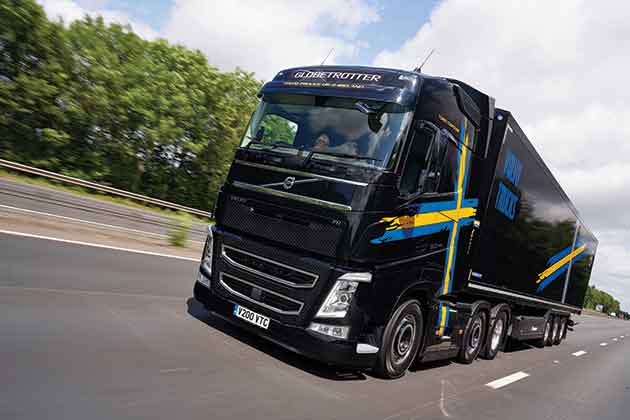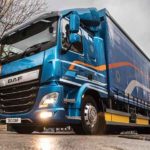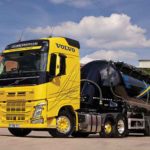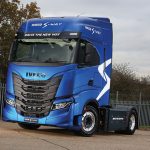
To run long haul routes more efficiently manufacturers have embraced ‘down speeding’ where engines work at lower revs. Now Volvo Trucks has gone one step further and reintroduced turbo-compounding. Kevin Swallow considers if this really works for the operator.
MANUFACTURERS have long toyed with turbo-compounding engines, and it’s a concept brought to market most successfully by the Swedes.
In the 1980s truck manufacturers Scania and Volvo started to look at technology where exhaust gas energy is recovered by a turbine and driven into the crankshaft, with Scania later introducing turbo-compounding as an option.
At the time Volvo’s chief engine designer Per Sune Berg explained that this technology fitted to an adapted 9.6 litre engine provided up to 50% of the total power output and delivered a 5% fuel improvement.
More recently, Volvo offered turbo-compound in 2001 with a D12 500hp engine to boost power and torque. It was available right up to the introduction of Euro 4/5.
So why has Volvo returned to turbo-compounding engines?
Turbo-compounding utilises the lighter, cheaper and more efficient D13K 12.8 litre engine while elevating its torque to the lower boundaries of the D16K that can support longer gearing and lower revs. In essence, a smaller engine working harder rather than a bigger engine working lazily.
Introduced back in March 2019, Volvo’s new I-Save option, which combines the D13TC Euro 6 Step D engine with turbo-compounding and updated fuel-efficiency features, ‘Could cut fuel costs by up to 7% in long haul operations’, according to the manufacturer.
For the driver this produces an additional 300Nm extra torque, which Volvo says means less acceleration and fuel is needed to keep a steady speed, making it the ideal solution for long haul customers, especially those who tramp more than 100,000 miles a year.
It comes at a price, both financially and in terms of weight. It is estimated to be around £4,000 more expensive than the D13K equivalent and weighs an extra 98kg.
Overwise the D13TC is identical to the D13K 12.8 litre six cylinder engine with overhead camshafts and common rail injection. This generation of turbo-compounding recovers excess energy in the exhaust gases to power the fly wheel via an additional turbine in the exhaust flow, known as the turbo-compound unit.
Turbo-compounding will be offered to two power ratings; 460 and 500hp, but not the 540hp. The Euro 6 rating is met via exhaust gas recirculation (EGR) set at around 10% so no EGR cooler is fitted, with the rest of the work done with selective catalytic reduction (SCR).
Standard D13K 460 (a true 453hp) offers 2,300Nm from 1,000-1,400rpm. With the D13TC that is increased to 2,600Nm from a slightly narrower rev band from 900-1,250rpm.
The D13K 500 (a true 493hp) has 2,500Nm from 900-1,400rpm, which increases by 300Nm to 2,800Nm from 900-1,250rpm.
That surpasses the 2,600Nm torque on the D13K 540hp, and edges closer to the bottom end of the D16K 550hp, which has 2,800Nm from a manual box and 2,900Nm with I-Shift automated transmission, and both working from 900-1,350rpm.
Turbo-compounding forms part of a new Long Haul Fuel Package, that includes I-Save as an updated version of I-See, the predictive cruise control system.
The Long Haul Fuel Package also has an updated I-Shift with long haul optimised software, I-Cruise with I-Roll, engine idle shutdown and power steering pump with variable displacement.
For Transport News, the specification is the D13TC FH500. It comes with the dual clutch options, and therefore has the 12 speed SPO2812 overdrive transmission. Subsequently it has the slightly slower 2.85:1 final drive axle ratio, whereas the same truck without the dual clutch and direct top transmission would get the 2.31:1 standard ratio.
The I-Shift dual clutch has been around since 2014. Using two dry clutches located at the front of the gearbox, one for odd numbered gears and the other for even, it is capable of producing split second changes.
One clutch idles while the other is engaged, it can pre-select the next gear while driving in the current gear. When a gear change is made the engaged clutch is released at the same time as the previously idling clutch is being engaged.
This means that the gear shifting is made with no interruption in power delivery. This also adds 100kg.
Options for chassis spec include a 3,900 and 4,100mm wheelbase, and for the extra 200mm there is a 15kg increase in weight. At 13,700mm, the wall-to-wall turning circle for the shorter wheelbase requires 600mm less than the longer version.
The workspace is the Globetrotter sleeper cab, which has 1,960mm standing space over the engine tunnel, and there is a 90mm drop into the footwell. For the record the Globetrotter XL cab is 2,110mm from the engine tunnel to the roof. There are two other cabs available too; the standard sleeper and the low roof sleeper. Selecting the Globetrotter adds 40kg over the standard sleeper.
Although it is a smaller cab than the usual Globetrotter XL, it’s still a decent workspace for the driver. It’s spacious, well equipped and does not lack for creature comforts with the Drive+ cab trim level and one bed package. The dark leather air suspended drivers’ seat is a good option; and the 33 litre under bunk fridge is a necessity on long haul.
Overall the truck weighs in at 8,556kg with full tanks and no driver. Go for the D13K engine with a standard clutch you’ll save 198kg.
With an automated transmission the driver probably won’t notice that much of a difference between the standard and turbo-compound engines.
The fuel saving lies in the reduced rev count. At the business end of the box from 10th gear through to top the changes in a turbo-compound are made around 1,200rpm, re-engaging at 950rpm.
In the D13K engine (Transport News, January 2018) changes were made from above 1,350rpm and usually fell into the next gear at 1,050rpm.
At 53mph (Transport News road test speed for the motorway), the engine rumbled along at a tad below 1,000rpm making use of the extra torque. And with I-Save the truck dipped into I-Roll more frequently than previous Volvo FH trucks fitted with its I-See predictive cruise control system.
As for lugging, changes down the box when under pressure are usually made around the 1,000rpm mark and popping back into gear at 1,250-1,300rpm. With I-Save it will work down to 900rpm if the crest of the hill is within its grasp. It is impressive.
It worked hard through the two climbs up Beattock (north on M74 past J14) only relinquishing one gear on each section. However, its lugability does not make for timely hill climbs. Neither timed ascent troubled the leader board.
Climbing the 2.5 mile Cairnie Braes Hill eastbound on the A9 Dunblane-Perth road, was recorded at 3min and 28sec, 16 seconds slower than the current record leader (Mercedes-Benz Actros1, TN, August 2018). It was also 13 seconds slower than the FH540 (TN, January 2018).
Both gear changes down the box at 47mph to 11th and then at 40mph to 10th gear, dug in at 1,000rpm before changing. That is 100-200rpm lower than just about anything else road tested.
South on the A702 from Edinburgh heading through Penicuik and Biggar towards Abington Motorway Services, the truck showed where it was happiest at 40mph; in 11th gear at 950rpm.
The turbo-compounding engine held the gear for the level sections, but changed quickly when extra load was exerted on any notable climb. It changed quicker if I-Save was engaged as the forthcoming slope was known and pre-empted.
At 30mph its 10th gear and 950rpm. Both situations show that down speeding is its default position.
In the past three years Transport News has put several Volvo FHs around its long haul route, many of which have featured the D13K engine. And 500hp is a popular choice for Scottish operators looking for consistency in terms of speed and performance over the undulating terrain, often willing to sacrifice a little fuel economy in the process.
Switching to a turbo-compound engine for the extra 300Nm of torque will make the D13K feel and respond like a D16K without the extra weight and cost.
The question is more to do with your operation; will the mileage and distance you cover justify the turbo-compound over the turbo-charged version?
As for this road test ,the journey time was similar albeit with slower climbs as the engine adhered to economy and efficiency rather than power to march over the top. Many operators will see a net benefit and turbo-compound will be suitable.




